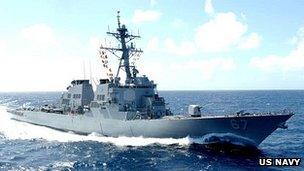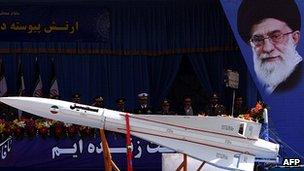Nato's missile defence shield 'up and running'
- Published



At its summit in Chicago this weekend, Nato is set to announce its new ballistic missile defence system has reached what it calls "interim operational capability".
This means that the first phase of the controversial scheme to defend Nato territory against ballistic missile attack will be operational.
But Nato's plans have many critics.
Some wonder if the system will work - and question whether there really is a missile threat to Nato territory at all.
Others fear it will poison relations between Russia and the West, delivering little real strategic benefit.
Nato has watched the spread of ballistic missile technology with growing unease.
If there is a potential ballistic missile threat to Nato countries then it can be summed up in one word - Iran.
However, a leading expert on missile defence technology, Professor Theodore Postol of the Massachusetts Institute of Technology, believes that this potential threat has been much overstated.
"The fundamental long-term threat from Iran is from nuclear weapons. But for now Iran does not have the bomb. A ballistic missile without a nuclear weapon," he says, "is like a terrorist bomber without an explosive vest."
For this reason, he believes, "there is no realistic threat to troops, cities, oil refineries, and the like from Iranian ballistic missiles. They can simply not carry large enough conventional munitions to do extensive damage on impact, and they lack the accuracy to hit prescribed targets with reliability".
More hardware
But Nato leaders and planners look at Iran's continuing nuclear programme - and the steady improvement it has made to the range and capabilities of its missile forces - and are convinced that missile defence is, at the very least, a prudent insurance policy.

A repaired USS Cole is patrolling the Mediterranean to detect and intercept incoming missiles
The initial defensive screen being unveiled by Nato this weekend rests upon: a network of US early-warning satellites; a new high-powered X-Band radar based in Turkey; and at least one Aegis-equipped US warship, deployed in the Mediterranean, capable of shooting down an incoming ballistic missile.
Some of Nato's European members will offer elements of their existing air defences - Patriot missiles in Germany and the Netherlands for example - to bolster the system.
Over time Nato's missile shield will expand with more anti-missile warships. Two land-based missile defence sites are also planned - first in Romania, and later in Poland.
Professor Sean Kay, an expert on the alliance, and Chair of International Studies at the Ohio Wesleyan University, believes that the Obama administration's phased approach to missile defence in Europe, which forms the basis of the Nato plan, is both prudent and sensible. But he believes that it also has a much broader political significance as well.
"Missile defence," he told me, "is a very important step towards re-invigorating the core collective defence foundation of Nato, which all the allies should appreciate."
Russia bristles
But Nato's missile defence plans are not without their critics. Moscow has signalled its fundamental opposition to the scheme; with Russian generals even going so far as to threaten to deploy nuclear-capable Iskander missiles against Nato missile defence sites in Romania and Poland.
So to what extent does Russia have a point?
Dmitri Trenin, Director of the Carnegie Center in Moscow is one of Russia's most acute strategic observers.
"Russia," he says, "sees US ballistic missile defence plans as global in scope".
The concern, he believes, is that "strategic defence impacts upon strategic offence; devaluing the deterrent value of Russia's own nuclear arsenal."
Mr Trenin accepts that the potential impact of the future system in Europe may initially be insignificant, but says that: "Moscow wants both formal assurances and an insight into the system's parameters, to be confident that the US has no intention of degrading Russia's own deterrent power, and that the Nato system has no capability against Russian strategic missiles. Washington's reluctance to give either raises Moscow's suspicions."
Prof Kay says Russia has made threats against Nato assets before.

Nato fears Iran's Sejil rocket could one-day carry a nuclear weapon
"During Nato enlargement they talked of mushroom clouds over new allies' territory," he says.
"In my view, they have enacted a fairly successful strategy over time of staking out an extreme position in order to complicate the decision process in Nato, and then reap some concessions. The problem now, though, is that we are getting all the negative and very little positive from that dynamic."
Dmitri Trenin shares this concern. He says Russian threats are aimed "at waking the European publics to the dangers inherent in Nato's missile defence plans if no agreement with Russia is reached".
He believes that for all the bluster Russia will act cautiously. But he insists that "a failure to engage Russia on missile defence will be a grave strategic blunder for Washington and its Nato allies. We have a couple of years, I think," he says, "to sort things out."
'Worst of both worlds'
Nato of course is confident that its new missile defence system will work. Earlier this month the US Missile Defense Agency conducted what it said was a highly successful test launch of a new and improved version of the Standard-3 missile (SM-3), which is a key component of Nato's future missile defence architecture.
But not everyone is so confident. "The SM-3 missile interceptor," Prof Postol told me, "has only been tested under non-combat conditions.
"All the tests have been characterised by extraordinary efforts to eliminate all objects that could possibly confuse the SM-3 kill vehicle. For these reasons and others, it is overwhelmingly likely that if the SM-3 is used in real combat, it will be total failure."
And he echoes some of Dmitri Trenin's wider concerns.
The paradox of missile defences, he told me, "is that even when they don't work, potential adversaries will treat them as if they do. Thus, producing the worst of both worlds - no defence but build-ups of offensive weapons to deal with those defences."
- Published10 May 2012
- Published3 May 2012
- Published19 November 2010